 Web browser company Opera today announce they’re bring their Web browser with AJAX support to chips for use in Consumer Electronics (CE) applications.
Web browser company Opera today announce they’re bring their Web browser with AJAX support to chips for use in Consumer Electronics (CE) applications.
It’s not long back that Opera made the decision to give their Web browser away after a long period of charging for it. A very brave and noble act many though – not a bad way to raise your profile we thought.
 They’ve been putting their browsers on different platforms for a while, like the mini-browser for mobile phones they brought out back in August 05.
They’ve been putting their browsers on different platforms for a while, like the mini-browser for mobile phones they brought out back in August 05.
The reasoning behind the give-away move becomes clearer today as they announce that they’ve been working with US chip company Sigma Designs to bring their browser software to embedded hardware via Sigma’s SMP8630 family of chipsets.
![]() Clearly looking to tread on Intel’s toes, Sigma say the SMP8630 family of chipsets can be used in digital media adapters, IPTV set-top boxes and networked DVD players that OEM’s may want to build.
Clearly looking to tread on Intel’s toes, Sigma say the SMP8630 family of chipsets can be used in digital media adapters, IPTV set-top boxes and networked DVD players that OEM’s may want to build.
To get to use the browser and the oh-so-desirable AJAX, OEM’s will need to get in touch with Opera to license their Software Development Kit (SDK). Once familiar with it they should be able to create some snazzy application.
So what’s so exciting about embedded Web browsing software? Their supports the darling of the hour buzzword – AJAX.
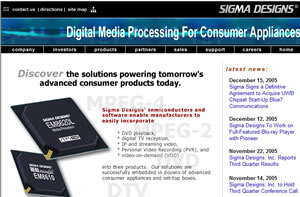 We’re sure you, dear reader, know what AJAX is, but just incase – it stands for Asynchronous JavaScript and XML. This translates to being able to use a Web browser more like a computer-based application.
We’re sure you, dear reader, know what AJAX is, but just incase – it stands for Asynchronous JavaScript and XML. This translates to being able to use a Web browser more like a computer-based application.
The most notable difference from a ‘normal’ Web app is information and updates can be carried out without needing reload the Web page each time. It’s an intergral part of the Web 2.0 landscape.
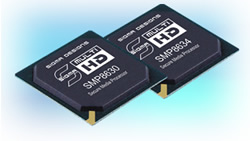 The most often cited example is Google’s Gmail.
The most often cited example is Google’s Gmail.
We at Digital-Lifestyles see the rise of AJAX as the event that broke Microsoft’s domination of computers. So pretty significant really.
Expect this news to generate great excitement in the Blog-world.
 We like “world firsts” so when integrated-circuit providers Micronas announced that they were the planet’s first company to incorporate a Dolby Virtual Speaker into a chipset designed specifically for televisions, we simply had to tell you all about it.
We like “world firsts” so when integrated-circuit providers Micronas announced that they were the planet’s first company to incorporate a Dolby Virtual Speaker into a chipset designed specifically for televisions, we simply had to tell you all about it.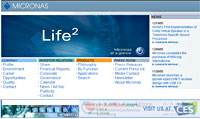 Dolby Virtual Speaker creates the illusion of five speakers by using room modelling techniques. This, apparently, sets it apart from other virtualizers.
Dolby Virtual Speaker creates the illusion of five speakers by using room modelling techniques. This, apparently, sets it apart from other virtualizers. Out just in time for overgrown boys to stick it on their Santa wish list, Mio Technology have announced their new Mio A201 integrated GPS model.
Out just in time for overgrown boys to stick it on their Santa wish list, Mio Technology have announced their new Mio A201 integrated GPS model. Mio are promoting the device as a ‘go anywhere’ portable sat-nav device which can be used for drivers, mountain bikes or walkers ambling through the countryside.
Mio are promoting the device as a ‘go anywhere’ portable sat-nav device which can be used for drivers, mountain bikes or walkers ambling through the countryside.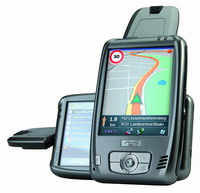 There’s the usual Outlook synchronisation options available, and we rather liked the new Compass Mode designed for navigating off road on foot or on a bicycle.
There’s the usual Outlook synchronisation options available, and we rather liked the new Compass Mode designed for navigating off road on foot or on a bicycle. LG Electronics’ PR department clearly don’t believe in a day of rest because Sunday saw them busily announcing the impending release of their LG PM 80, a PDA capable of receiving T-DMB (terrestrial digital multimedia broadcasting).
LG Electronics’ PR department clearly don’t believe in a day of rest because Sunday saw them busily announcing the impending release of their LG PM 80, a PDA capable of receiving T-DMB (terrestrial digital multimedia broadcasting). The actual device, presented here in the traditional manner by near-ecstatic Korean ladies (if only we got so much unbridled joy from our gadgets) follows the traditional PDA form factor, with the addition of an old-school pull out aerial for TV reception.
The actual device, presented here in the traditional manner by near-ecstatic Korean ladies (if only we got so much unbridled joy from our gadgets) follows the traditional PDA form factor, with the addition of an old-school pull out aerial for TV reception. As ever, the Koreans will get to play with this device for ages before we even get a peek at it – if they don’t decide to keep it to themselves for ever, of course.
As ever, the Koreans will get to play with this device for ages before we even get a peek at it – if they don’t decide to keep it to themselves for ever, of course. The best thing about Samsung’s press photos is that they always feature groups of attractive young ladies deliriously happy to be touching their latest products.
The best thing about Samsung’s press photos is that they always feature groups of attractive young ladies deliriously happy to be touching their latest products. Coming in two parts – the laptop and its detachable 19″ screen – we were confident that we’d be in for double the fun and, sure enough, we were rewarded with happy-clappy shots of two ladies near-ecstatic to be fondling the electronics.
Coming in two parts – the laptop and its detachable 19″ screen – we were confident that we’d be in for double the fun and, sure enough, we were rewarded with happy-clappy shots of two ladies near-ecstatic to be fondling the electronics. Happily, Samsung have had the nous to ensure that they used standard monitor connectors too, so that the laptop can be connected to a bigger screen (for giving a corporate presentation, for example) – and even the display can be used with a different PC.
Happily, Samsung have had the nous to ensure that they used standard monitor connectors too, so that the laptop can be connected to a bigger screen (for giving a corporate presentation, for example) – and even the display can be used with a different PC. Full technical details, pricing and availability is yet to be announced, but we can tell you that the laptop packs a whopping 19″ WSXGA+ (1680×1050) HDTV compatible screen and is powered by a Pentium M770 (2.13GHz) CPU.
Full technical details, pricing and availability is yet to be announced, but we can tell you that the laptop packs a whopping 19″ WSXGA+ (1680×1050) HDTV compatible screen and is powered by a Pentium M770 (2.13GHz) CPU.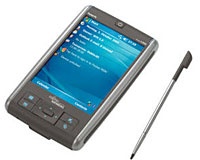 Fujitsu Siemens have launched the “first handhelds with fully integrated GPS functionality”, the Pocket LOOX N500 and Pocket LOOX N520 PDAs.
Fujitsu Siemens have launched the “first handhelds with fully integrated GPS functionality”, the Pocket LOOX N500 and Pocket LOOX N520 PDAs. Powered by an Intel XScale PXA270 312 MHz CPU, the devices come with a SD/MMC slot (with support for SDIO), USB 1.1, IrDA and Bluetooth, with the Pocket LOOX N520 offering integrated wireless LAN 802.11g Wi-Fi.
Powered by an Intel XScale PXA270 312 MHz CPU, the devices come with a SD/MMC slot (with support for SDIO), USB 1.1, IrDA and Bluetooth, with the Pocket LOOX N520 offering integrated wireless LAN 802.11g Wi-Fi.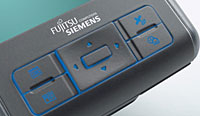 There’s also a ton of Fujitsu Siemens-branded applications bundled in the package, including Voice recorder, AudioPath and Key Look, along with a Microsoft Mobile suite including Excel, Power Point, Outlook and Internet Explorer.
There’s also a ton of Fujitsu Siemens-branded applications bundled in the package, including Voice recorder, AudioPath and Key Look, along with a Microsoft Mobile suite including Excel, Power Point, Outlook and Internet Explorer.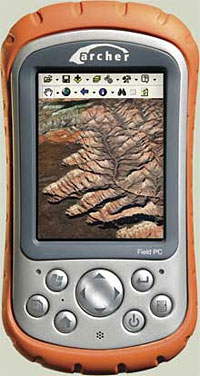 Hardcore outdoor types with lantern jaws will be whooping in their Goretex trews at the prospect of getting their hands on the new rugged Archer Field PC Pocket PC by Juniper Systems.
Hardcore outdoor types with lantern jaws will be whooping in their Goretex trews at the prospect of getting their hands on the new rugged Archer Field PC Pocket PC by Juniper Systems. Also bundled in the package is Microsoft ActiveSync 4.0, Terminal Services Client, Microsoft Windows Media Player 10 Mobile, MSN Messenger and Pocket Internet Explorer.
Also bundled in the package is Microsoft ActiveSync 4.0, Terminal Services Client, Microsoft Windows Media Player 10 Mobile, MSN Messenger and Pocket Internet Explorer. Japan’s largest annual IT show, Ceatec (Combined Exhibition of Advanced Technologies), opens today and will feature around 700 companies, according to the organisers.
Japan’s largest annual IT show, Ceatec (Combined Exhibition of Advanced Technologies), opens today and will feature around 700 companies, according to the organisers.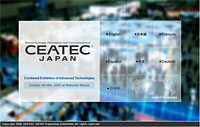 Toshiba has promised to display a super-slim 12.7 millimetre high drive designed for laptops which can read HD-DVD discs and read and write DVDs and CDs.
Toshiba has promised to display a super-slim 12.7 millimetre high drive designed for laptops which can read HD-DVD discs and read and write DVDs and CDs. Earlier this month Samsung got a lot of attention when they
Earlier this month Samsung got a lot of attention when they 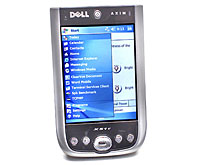 Dell has announced three updates to its popular Axim PDA series, headed up by the powerful, VGA-enabled X51v.
Dell has announced three updates to its popular Axim PDA series, headed up by the powerful, VGA-enabled X51v. One big difference from previous models is the use of non-volatile memory, which means that the new Axim X51v uses RAM exclusively for running programs and stores all programs and data in flash.
One big difference from previous models is the use of non-volatile memory, which means that the new Axim X51v uses RAM exclusively for running programs and stores all programs and data in flash. Connectivity is taken care of with integrated Bluetooth 1.2 and Wi-Fi 802.11b support, with WPA and LEAP security for the latter.
Connectivity is taken care of with integrated Bluetooth 1.2 and Wi-Fi 802.11b support, with WPA and LEAP security for the latter.